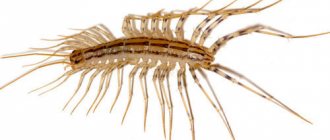Parasitic organisms live at the expense of other creatures, robbing them of useful microelements. Against the background of nutrient deficiency, extensive intoxication occurs with waste products of parasites, therefore, the internal organs of the infected person lose their functionality. In severe and advanced cases, this can lead to death.
Some parasitic diseases of domestic animals pose a serious danger to humans. For this reason, owners should know the main symptoms of the presence of parasites in cats, which depend on the type of pathogen.
Skin parasites (external)
The most common parasites that live on the fur and skin of pets are fleas, ticks and lice.
Fleas
Fleas feed on the blood of cats and kittens, leaving behind characteristic black dots (excrement) that some pet owners mistake for laying eggs. In fact, flea eggs are found in secluded places in the apartment (under baseboards, in carpets and animal bedding, in the upholstery of upholstered furniture) and look like colorless small grains. The eggs transform into larvae within 2-14 days. And after a few more days or months (depending on conditions), the larva becomes an adult.
Fleas are unique insects. They can jump to heights hundreds of times greater than their own size, and can go without food for up to several months (this applies to adult individuals). If there are no animals nearby, they also feed on human blood. The favorite habitats on the body of cats for fleas are the neck, withers, tail, stomach, sides, and head.
Lice
Insects with a dense body, flattened downwards, translucent, with a triangular head. They feed on particles of skin and fur, so their favorite habitats are places with increased hairiness. But lice also suck blood. Hair (wool) is not only food, lice attach their eggs (nits) to it, up to 7 per day. New insects hatch from the eggs after a few days.
Ticks
They come in ixodic and auricular types. They are considered the most dangerous insects that parasitize the body of an animal. Ticks have a flat body 0.3-0.7 mm long, but a female that has eaten enough becomes similar in shape to a bean. Hungry ticks are white or brownish in color, while engorged ticks turn grayish. Ticks live in the ears, on the back, and chin. The female lays up to 5 eggs per day, from which larvae appear on the 4th day, then nymphs.
The ear mite is an external parasite with an oval-shaped body, dirty yellow in color, up to 0.6 mm long. It is distinguished by powerful jaws and short legs (4 pairs). It can settle inside the ear and directly in the auricle. Causes scabies, ear inflammation.
The Ixodid tick is a parasite with a flat oval body. Females are spotted, males are brownish-gray. They feed on the blood of cats.
lice eaters
An insect with a body 1-2 mm long, light brown in color (it can also be whitish or yellowish). Refers to external skin parasites. They are distinguished by a large head, undeveloped chest and legs with hooks at the end. It parasitizes the hair of cats, causing hair loss, the formation of weeping wounds, and allergies. Infection occurs through contact with a sick animal or parasite eggs from the soil.
What to do if cats are infected with parasites
Treatment options for cat parasites depend on the type of parasite, the age of the animal, and the severity of the disease. The main emphasis is on destroying the pathogen. Additional measures include relieving associated symptoms, a therapeutic diet, and external treatment of skin lesions.
Why is diagnosis by a veterinarian so important?
All the described symptoms are non-specific. They are characteristic not only of parasitic diseases, but also of systemic ones. In the latter case, treatment with antiparasitic drugs will not only not give the desired result, but will also aggravate the course of the disease due to increased intoxication.
We also must not forget about the danger of infecting others. Many of the described pathogens are transmitted to humans, so at least basic safety measures should be observed before making a diagnosis.
In addition to the external examination, diagnosis at the veterinary clinic includes the following studies:
- stool, blood and urine tests to detect helminth eggs and disturbances in the systemic blood flow;
- skin scrapings to determine the type of ectoparasite;
- light microscopy, revealing changes in the contour and color of red blood cells;
- smears and swabs from mucous membranes where toxoplasma lives;
- Ultrasound and x-rays assessing the general condition of internal organs.
Based on the data obtained, the veterinarian draws up an individual treatment plan. The duration of taking medications depends on the results of new tests, and until this point it is not recommended to deviate from the prescribed regimen.
Destruction of pathogens
Antiparasitic drugs are available in several forms. These include:
- Collars
. Repels ectoparasites. They are effective only as a preventive measure and often cause allergies.
- Shampoos
. Suitable for treatment and have hypoallergenic properties. The problem with using them is that very few cats like water treatments.
- Drops on the withers
. They are applied along the spinal column and destroy the pathogen in a short period. May provoke an allergic reaction.
- Sprays
. Basically they protect only the fur, that is, they are more suitable for prevention. Can be used not only on animals, but also on various surfaces.
- Pills
. They have the most powerful and long-lasting effect, but they are quite problematic to feed to a cat.
- Suspensions and pastes
. Unlike tablets, they have a more pleasant consistency and aroma. Suitable for treating kittens and capricious pets.
In addition to the listed remedies, the veterinarian may recommend antihistamines, hepatoprotectors, glucocorticosteroids, diuretics, antidiarrheals, antiemetics and probiotics. Their main task is to relieve associated symptoms and improve the functioning of the affected organs.
IMPORTANT!
Animals in serious condition are treated in a hospital with the help of droppers and oxygen chambers.
Additional measures, care and diet
Additional measures include treating the premises and the pet’s wounds. The patient’s personal belongings are boiled or thrown away, and all surfaces are treated with insecticidal sprays or soda solution.
When caring for an infected pet, it is important to remember to wash your hands after each contact. It is advisable to use rubber gloves. Until recovery, it is recommended to keep the cat in a separate room, preventing communication with other pets.
The therapeutic diet is prescribed individually, but in most cases it requires adherence to the following rules:
- Fractional meals. Small but frequent portions reduce the load on the gastrointestinal tract and facilitate the absorption of food.
- Focus on low-calorie but filling foods: chicken, turkey, cottage cheese.
When dry feeding, use medicated feed from a familiar manufacturer. This eliminates long-term addiction through gastrointestinal disorders.
Internal parasites
These types of parasites live in the internal organs of representatives of the cat family, affecting the liver, gall bladder, and intestines.
The most common ones are:
1) Cestodes.
Reach up to 70 cm in length. The walls of the small intestine are affected. The larvae resemble sesame seeds in appearance. They come out with the animal's feces. If the infection is severe, the larvae can be found in the vomit or on the cat's bedding.
2) Cucumber tapeworm.
A parasite reaching up to 30 cm in length. Lives in the intestines. It can cause a very dangerous disease – dipylidosis, which leads to disturbances in the functioning of the digestive system. Transmitted from carriers (fleas, sick animals).
3) Roundworms.
These are roundworms that reach a length of up to half a meter. An animal becomes infected by ingesting roundworm eggs. In small quantities, roundworms do not cause discomfort in the animal, but in advanced cases, alarming symptoms can be noticed (vomiting, the appearance of worms in the feces). They move through the small intestine and can clog it if there are too many of them.
Signs of roundworms, methods of deworming
The most common cat parasite is roundworms. The whitish worms reproduce in the intestines and can reach 13 centimeters. They usually come out in excrement, with sputum when coughing. If cats have worms:
- loose stools are observed;
- cough appears;
- eyes become dim;
- wool loses its shine;
- Appetite increases greatly.
The kitten's belly may become bloated.
The main means of combating worms are drugs made on the basis of piperazine. The dosage is selected taking into account the weight of the animal and its age. It is necessary to strictly observe hygiene rules and carry out regular preventive measures. Anti-worm medications should be given once a year. Deworming includes 2 procedures with an interval of 10 days.
It is impossible to remove roundworms from a sick animal. In this condition, medications containing piperazine are deadly for your pet. Pregnant and lactating cats are not dewormed.
Symptoms of parasites in a cat
Symptoms of parasites in cats do not always appear suddenly. The owner may not understand that the pet has been attacked by parasites.
It is worth paying attention to the following signs:
- Anxiety. The cat is constantly itching, licking, biting its fur;
- Wounds, bleeding places when scratched, baldness;
- The appearance of insects on wool, their excrement, nits;
- Brown crusts in the ears (due to ear mites), redness and soreness of the auricle;
- The appearance of flea excrement and adult individuals (brown shiny insects with a body flattened on the sides and long hind legs) on the animal’s fur.
Internal parasites do not cause such severe symptoms as external parasites.
Their presence is evidenced by:
- Constant vomiting;
- Refusal to eat;
- Strong general weight loss, but at the same time the stomach becomes disproportionately bloated;
- Diarrhea;
- Apathy;
- Stunted growth of young cats;
- Purulent discharge from the eyes.
These are alarming symptoms; it is necessary to show the animal to a veterinarian, so that after examination and assessment of the condition, he can prescribe a remedy for parasites for cats and recommend an individual dosage.
Coccidia and toxoplasma
Coccidia are single-celled parasites that penetrate the epithelial surface. They multiply directly in tissue cells, which leads to their destruction. A cat becomes infected from other individuals carrying the pathogen. When coccidia appear:
- there is regular diarrhea;
- blood appears in the feces;
- weight is lost and exhaustion sets in.
Veterinarians have drugs in their arsenal that destroy these parasites. It is important to strictly follow hygiene rules and destroy cat litter by burning it.
A special type of coccidia is Toxoplasma. These parasites destroy the tissue of the visual organs, lymph nodes, and brain. For cats, this type of parasite is considered natural; in small quantities they do not threaten the animal’s body. But infection with toxoplasma is extremely dangerous for pregnant women. These parasites can cause abnormalities in the fetus.
Treatment
You can get rid of external parasites yourself. There are many good veterinary medications on the market for fleas, lice, and ticks for adult animals and kittens. They come with detailed instructions, so it is impossible to make a mistake with the dosage. Treating a cat against parasites is carried out simultaneously with disinfection of the pet’s apartment and bedding.
To get rid of ticks, fleas, and lice eaters, special alcohol and oil drops are used on the withers and collar, soaked in essential oils. Shampoos, ointments, and sprays containing chlorhexidine and benzoyl peroxide are used. Additionally (as prescribed by a veterinarian), immunostimulants are used. Secondary infection requires antibacterial therapy.
Treatment of helminthiasis is carried out with anthelmintic drugs. They are available in tablets and as a paste in special dispensing syringes. Cats are given the drug once in the morning feeding. Cucumber tapeworm is treated with the help of febantel and praziquantel and simultaneous treatment of the animal's fur for fleas.
Parasites of domestic cats are an integral part of their lives.
Even good daily care cannot save you from them. After all, parasite eggs are present everywhere, in the soil, raw food, and in the cracks of the floors. People can bring them on clothes and shoes from the street. The salvation is constant prevention and regular examination of your pet by a veterinarian. Share with friends:
Hookworms and tapeworms
Hookworms, which suck blood from the vessels located in the intestinal walls, pose a particular danger to cats. This leads to anemia. Most of these parasites are found in the United States. In other countries they are extremely rare.
Tapeworms can settle in parts of the intestines. This is a type of tapeworm. The head of the parasite is attached to the intestinal wall. The eggs mature in the terminal segment, which falls off and comes out with excrement. If tapeworms are present, small white grains can be seen on the hairs in the anal area. They may still be alive and moving. It is easier to notice segments with eggs on dark fur.
Tapeworms enter the animal's body in various ways. If a cat hunts or walks outside, parasites can come from mice and rats. Fleas can bring them to pets. In veterinary pharmaceuticals there are special drugs that destroy tapeworms. They should also be used as a preventive measure if the cat has free access to the street and is an avid hunter. The dosage of the drugs must be determined by a veterinarian.
Ticks
Most often, animals suffer from ear mites. These skin parasites in cats take up residence in the ear canal, forming a reddish-brown substance that causes severe itching. Therefore, the animal constantly shakes its head and scratches its ears until they bleed. It is quite simple to make sure that the cause of this behavior is an ear mite. It is enough to wipe the inner surface of the ear with a cotton swab and carefully examine the removed plaque, in which white insects and their reddish secretions are clearly visible through a magnifying glass.
Ear mites cause complications. Their presence can lead to otitis media, deafness, and meningitis. Treatment is carried out in the form of treatment with special drugs. It is first necessary to thoroughly clean the ear from brown plaque.
Subcutaneous mites are less common. They live in the thickness of the animal’s skin, causing irritation and itching. As a result of scratching, crusts form and hair falls out in the affected areas. The disease can only be diagnosed in laboratory conditions by analyzing scrapings from the animal’s skin. Based on the research results, treatment is prescribed.
Fleas
These blood-sucking brown insects live almost everywhere. They can even be found in carpets, rugs and upholstered furniture. They are distinguished by their ability to perform huge jumps relative to their size. The habitat for fleas is mainly animal fur.
These are the most common external parasites in cats. Treatment should not be delayed. Large numbers of fleas can cause severe disease. The bites of these insects lead to severe itching, which causes the cat to itch intensely and bite off fleas. It is from this symptom that one can suspect the presence of parasites in an animal. Scratching and inflammation appear at the site of the bite, and insect waste products can be found on the fur.
Fleas can carry helminths. Therefore, at the first signs of a flea infestation, it is necessary to take appropriate measures. It is necessary to treat not only the animal itself, but also the entire apartment. The cat must first be bathed. After this, treat the wool with an anti-flea agent, having first consulted with a veterinarian about which drug is best to use.
These pale gray blood-sucking insects also sometimes cause a lot of suffering to pets. These parasites in cats are identified by the restless behavior of the animals, the presence of scratching, and upon careful examination, both the eggs laid on the fur and the lice themselves can be seen with the naked eye. The treatment is practically no different from flea treatment.
Nematodes
This type of internal parasite is less common than roundworms, but can cause equally serious health problems. There are practically no symptoms at the initial stage of infection, which makes it difficult to make a timely diagnosis. Manifestations of an advanced form of the disease are diarrhea, blood in the stool, and weight loss of the animal. Nematodes are transmitted through infected animals and the ingestion of infectious eggs and larvae. A pregnant cat infected with nematodes can pass the infection to her unborn kittens.
It is necessary to carry out mandatory preventive treatment of the animal with anthelmintic drugs, since parasites in cats that are transmitted to humans through normal contact can cause serious diseases, especially in children.
How to give your cat deworming medicine
Many owners are faced with the problem of how to give a pill to a cat. Pets resist in every possible way the owners’ attempts to open their mouths and push an incomprehensible bitter thing into it. To prevent physical and mental injury on both sides, you can use a number of proven techniques:
- crush the tablet into powder and pour it into your mouth;
- dissolve the tablet in a small volume of water, draw it into a syringe and pour it into the cat’s mouth;
- use the tablet dispenser.
What parasites pose a danger to humans?
Of the ecto- and endoparasites considered, you should be wary of fleas, ixodid ticks, toxoplasma and helminths. All of them, except toxoplasma, are transmitted by contact.
You can become infected with toxoplasmosis only during the removal of feces, and the disease itself is generally mild. Complications develop only with weakened immunity, so the risk group includes pregnant women, children under 3 years of age and the elderly.
Subcutaneous parasites and lice eaters are not dangerous to humans, since their mouthparts are not adapted for gnawing through our skin. They are also not happy with their lower body temperature compared to cats. In the worst case scenario, you will end up with bites and redness. The exception is sarcoptic mange (scabies).
Hemobartonellosis is an exclusively feline disease, so it is not transmitted to people or dogs. Transmission of other blood parasites is possible only through ticks. Also, do not be afraid of coccidia.
ADVICE!
Do not let your pet lick wounds on your skin until he gets better, and treat your hands with antiseptic or regular soap after each contact.
How to properly rid a cat of worms
In order for your pet to be treated for helminths with the greatest effectiveness, firstly, you should carefully study the instructions for the medicinal product. It is important to strictly follow the dosage recommended by the veterinarian or the annotation (in case of self-therapy). Before starting treatment for helminthic infestation, the animal must be treated for external parasites.
Some cats manage to hold the pill in their mouth and then spit it out, so the owner must not only place the medicine in the pet's mouth, but also make sure that it is swallowed.
In most cases, deworming medication is given to the cat twice, with an interval of two weeks. This is due to the life cycle of parasites. If the disease is advanced, the doctor may prescribe longer therapy.
After deworming, you must make sure that the activities were successful. This will require repeated control tests.
Possible complications in the absence of prevention and treatment
- Fleas provoke skin inflammation because they feed on animal skin flakes and blood. Ticks, fleas and mosquitoes are the source of a vector-borne infection called infectious anemia (hemobartonellosis). Its causative agent is hemobartonella. It becomes more active in the spring and summer due to insect vectors. Animals experience anxiety, pain, and blood loss is life-threatening.
- Helminths affect the cat's immune status. She can get pneumonia, sepsis, and get toxic liver damage.
- A sick pet can infect other animals living in the house, small children and adults.
Monitor your pet’s behavior and do not let the situation take its course if you suspect an infection. Timely prevention is a guarantee of the cat’s health and well-being.
When not to deworm
There are several situations when you need to wait a little while treating cats for worms:
- serious condition of the pet;
- exacerbation of infectious diseases;
- cat pregnancy;
- lactation period;
- newborn kittens (usually age restrictions are indicated in the annotation for the drug).
It may also be difficult to deworm an aging cat. At this age, an animal should be treated for worms only in consultation with a specialist.











